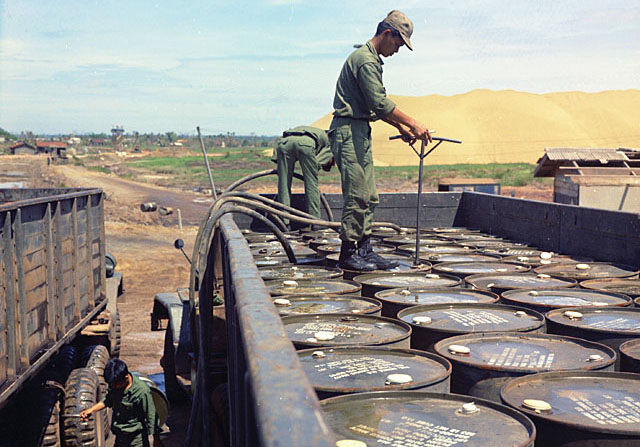 |
||||||||||||
|
AGENT ORANGE: THE TOXIC BATTLEFIELD COMES HOME, May/June 2012
CIVILIANS IN VIETNAM: BY WILLIAM TRIPLETT
For many Vietnam veterans, the controversy was resolved in great part by the Agent Orange Act of 1991, which established a presumed connection between exposure to Agent Orange and a list of diseases and illnesses, including certain cancers. While the landmark legislation couldn’t give veterans their good health back, it did force open a door that had, until then, been closed to them—a door to much-needed compensation and other related benefits. Veterans understandably rejoiced. But what about civilians exposed to Agent Orange? According to the federal government, between 72,000 and 171,000 American civilians may have worked in Vietnam between 1964 and 1974. The number can’t be narrowed any further because surviving records are scant. In 2005 the U.S. Government Accountability Office counted a mere handful of civilian claims—thirty-two—requesting compensation for diseases that the VA recognizes as service-connected to Agent Orange exposure. But GAO acknowledged there could be many more looking for help.
There has been comparatively little, if any, official action taken on civilians who were in-country and later developed ailments that are on the VA’s Agent Orange service-connected list. Lesli Dahlke discovered this about three years ago. Part of a USO tour to Vietnam in 1970 and later diagnosed with soft tissue sarcoma (which is on the VA’s list), she called the agency for help. “I was told they couldn’t help me because I was not a veteran,” Dahlke said. “I had gone over as a guest of the Army, but I wasn’t employed by the Army. End of call.” Dahlke had visited all four Corps while in Vietnam, often traveling to remote areas that official records show were sprayed—sometimes heavily—with Agent Orange before and during her time in-country. She lived an otherwise normal life until 1990, when she was diagnosed with a type of sarcoma rare for a woman of thirty-eight with no family history of cancer. But it wasn’t until 2009, years after a ten-hour surgery removing five internal organs along with an eight-pound tumor, that she even learned that her type of cancer was presumed to be connected to Agent Orange exposure in Vietnam. By then, Dahlke and her husband already had been forced to sell their home and file for bankruptcy because of medical bills. True, she had only been in-country less than three weeks. But the VA’s website clearly states that service-connection is presumed for anyone who “set foot in Vietnam,” including “brief visits.” Only the VA, however, has presumed such a connection. Meaning, as Dahlke learned when she first called the VA, “the burden of proof is different if you’re not a veteran. It’s on you.” With no scientific studies proving a conclusive link—though some research strongly suggests it—that’s a burden of proof almost impossible to meet. As the GAO noted in its review of thirty-two civilian claims, “most have been denied. Denials…stemmed, in part, from the fact that under the laws governing these claims, claimants must demonstrate a causal link between their exposure to Agent Orange and their medical conditions, which is difficult to prove so many years later.” The denying agency: The Department of Labor (DoL), which oversees the only system open to civilian claims of injury resulting from governmental service. That system was created with the Federal Employees’ Compensation Act of 1916, but it did not have a designation for Agent Orange-related claims until 2005, more than three decades after the Vietnam War officially ended. Dahlke filed a claim with DoL. Denying it, the department said, “The evidence did not establish the claimed exposure.” She provided additional material. “I have a box of forty-year-old maps of where I had been. I have a diary with entries of all the places.” DoL again denied. Dahlke has filed a formal appeal and is awaiting a decision. She hopes to hear soon. In May 2010 she was diagnosed with a rare form of leukemia. In August 2011 she discovered she has lymphoma. Dahlke’s oncologist at the Mayo Clinic told her that both fall within the classification of cancers on the VA’s list of diseases presumed to be linked to Agent Orange exposure. “Since July 1990 we’ve paid out of pocket almost $1 million in medical bills,” said Dahlke, who hasn’t been able to work since that year. “I would like to be reimbursed for those costs and for costs going forward. I would like to know I have money coming in to survive. I’m just looking for what is fair and is already on the books.” For additional information, see Lesli Dahlke’s website, www.alossofinnocence.com.
|
||||||||||||
 |
||||||||||||
 |
||||||||||||
| |
||||||||||||
|
||||||||||||
8719 Colesville Road, Suite 100, Silver Spring. MD 20910 | www.vva.org | contact us |
||||||||||||







 Given the voluminous research, study, examination, and debate that has proliferated over the last forty years about Agent Orange, one might feel safe in assuming that most every aspect of the highly toxic herbicide and its effects on human health has been hashed over in some way, if not fully resolved.
Given the voluminous research, study, examination, and debate that has proliferated over the last forty years about Agent Orange, one might feel safe in assuming that most every aspect of the highly toxic herbicide and its effects on human health has been hashed over in some way, if not fully resolved.